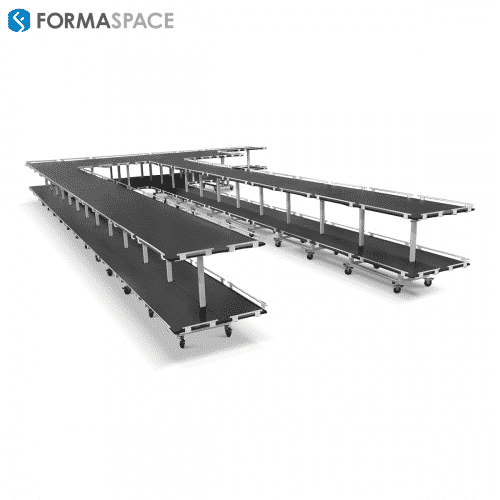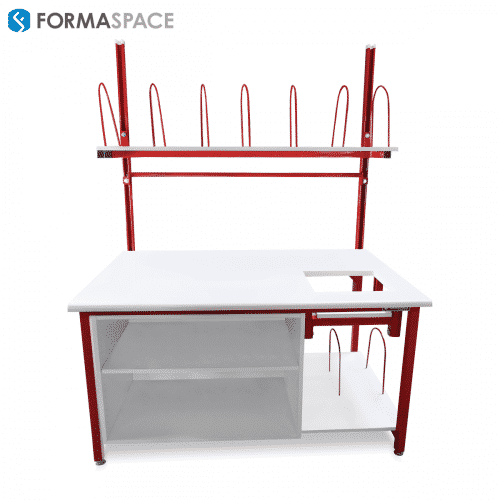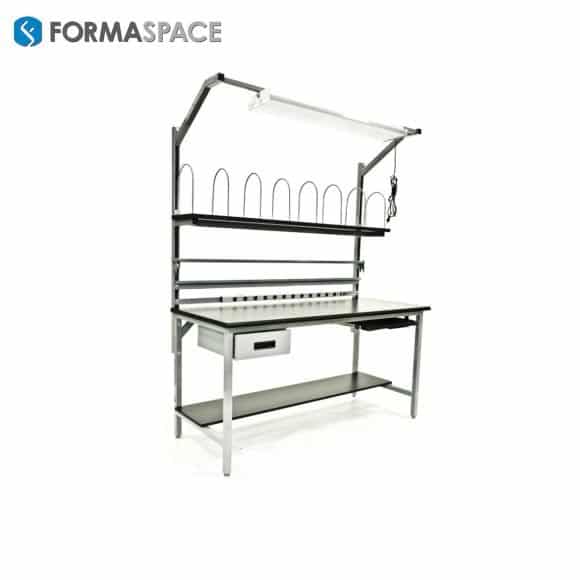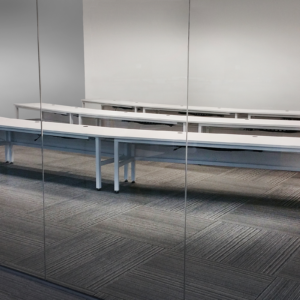It was the Best of Times. It was the Worst of Times.

If you were to judge the extent of American transportation bottlenecks by the speed of Amazon package deliveries – with millions of items available for delivery to your doorstep in a few days or in some cases just a few hours – you might come away thinking we are in a golden age of delivery logistics.
But to achieve this remarkable “Best of Times” experience, Amazon has made unprecedented investments in its transportation logistics infrastructure. Since ramping up its delivery operations in 2014, Amazon has delivered over 10 billion packages – with 72% of them shipped via Amazon’s far-flung network, which now boasts:
- 400,000 Amazon Drivers
- 40,000 Amazon Semi Trucks
- 30,000 Amazon Vans
- 500+ Amazon Logistics Facilities
- 70 Amazon Cargo Planes
- $1.5 billion dedicated Amazon Air Hub at Cincinnati/Northern Kentucky International Airport
Most recently, Amazon has sought to bypass the cargo shipping container backlog by chartering its own cargo ships.

Only a few retail giants (Walmart, Home Depot, Costco come to mind) can compete, but even these companies can’t match the full spectrum of Amazon’s infrastructure investment ambitions (which now includes shipping non-Amazon orders to compete with FedEx and UPS on its network.)
So where does that leave everyone else?
For Those Relying on America’s Deteriorating Infrastructure, it is the “Worst of Times.”
America’s crumbling transportation infrastructure can best be described as an underfunded Dickensian poor house. Most of us have to endure the brunt of transportation delays on a daily basis – from overcrowded, potholed highways and gridlocked city streets that tear up vehicle tires and suspensions at an alarming rate – to the very real possibility that highway overpasses and bridges you commute to work or send your kids to school on will collapse unexpectedly.
The result is a cascading effect that is exacerbating the ongoing supply chain crisis – leading to problems such as the unprecedented delays in US Post Office first class mail delivery – all of which add up to significant pain points for individuals and businesses trying to conduct everyday transactions.

Why is the American Transportation Network Falling Apart?
Several factors are coming together at once to create a crisis situation in the American transportation network, including:
· Structures Outliving their Useful Life
Much of American infrastructure has outlived the “useful life” set forth by the original civil engineers and transportation designers who built them. For example, the first of New York City’s subways opened in 1904, and even “modern” transit systems, such as San Francisco Bay Area’s space-age BART (opened in 1972) and Washington DC’s Metro (opened in 1976), have or will soon be 50 years old. Likewise, interstate highways dating back to the start of the Eisenhower-era Federal-Aid Highway Act of 1956 (which kicked off the interstate highway building boom) are approaching their seventh decade in service.
· Population Growth / Shifting Demographics
The US population has grown significantly since much of our transportation network was planned and constructed – keep in mind that in 1950 there were only 150 million of us, but the 2020 census now counts nearly 330 Americans, a 220% increase. Adding to the problem, Sunbelt metros have grown rapidly at the expense of northern cities. For example, in 1950, Philadelphia and Detroit were the third and fifth largest cities, while Houston was 14th and Phoenix was 99th! Today, Houston is fourth, and Phoenix has shot up to fifth place. Overall population growth strains our existing transportation infrastructure, but the fast-growing regions, which tend to rely more heavily on car and truck traffic to move people and goods around, are especially hard hit.
· Supply Chain Trading Patterns
Trading patterns have also changed dramatically since much of our infrastructure was first designed. As rapid delivery has taken hold thanks to the e-commerce revolution, airports have had to expand cargo capacity, leading to the rise of dedicated cargo terminals for UPS, FedEx, and now Amazon to bypass crowded public airports. And since so many goods are now produced overseas, our coastal ports are under stress to handle the massive amounts of the now ubiquitous intermodal cargo containers (which, by the way, were still in development in the mid-1950s and only standardized in 1970). Finally, many of our nation’s east coast ports are also still playing catch up – needing to dredge deep water channels to handle the new class of Panamax cargo ships that pass thru the Panama Canal’s new wider and longer lock and channel system.
· The Effects of Climate Change and Need for Disaster Preparation
Transportation systems are also increasingly at risk due to higher ocean water levels, stronger hurricanes, and more intense rainfall (east of the Rockies), which have over the years washed out railway lines and forced closures of major highway networks. Out west, record high temperatures have caused highways and bridges to buckle, while wildfires and smoke have shut down highways for days at a time. Finally, a better understanding of seismic conditions up and down the West Coast has increased the urgency of retrofitting or replacing structures vulnerable to seismic shaking.
Importance of the Newly Passed Infrastructure Investment and Jobs Act (IIJA)
Since 2020, Amazon has invested nearly $74 billion in capital expenses, largely to build out its logistics network, in an effort that analysts say will help the company double its delivery volume by 2025.
Meanwhile, government infrastructure spending has been shrinking.
According to the Brookings Institute, overall Federal, state, and local infrastructure spending actually fell by $10 billion (in inflation-adjusted dollars) during the ten years between 2007 and 2017, dropping from $450.4 billion in 2007 to $440.5 billion in 2017.
But it gets worse. Remember, that’s the topline government spending number. The actual amount of spending dedicated to transportation infrastructure (including roads, bridges, rail, transit, aviation, and ports/waterways) was only 68% of the topline spending number – and it dropped from $303 billion in 2007 to $298 billion in 2017. Furthermore, the Federal government’s funding share within the mix dropped during this period, leaving state and local funding sources to pick up the slack in an effort to help get transportation projects moving again.
For argument’s sake, let’s mix apples and oranges for a second and compare Amazon’s recent $74 billion capital expenses spending with the topline Federal, state, and local infrastructure budget of $440 billion (in 2017). A back-of-the-napkin calculation shows Amazon’s recent capital spending is roughly 17% of the government’s 2017 annual spending on infrastructure.
This means Amazon is either spending far too much or the government is spending far too little. Since Amazon packages can be delivered overnight, and our transportation system is hugely out-of-date, common sense would say government spending hasn’t kept up.
That’s why the new Infrastructure Investment and Jobs Act (IIJA) is such important legislation – it will help fund an additional $500 billion for roads, bridges, highways, mass transit systems, and railroads.
Is it enough?
Frankly, the answer is no, at least in the opinion of the American Society of Civil Engineers who have given the American infrastructure a Grade of C-. They estimate we need to spend nearly $2.6 trillion over the coming 10 years to upgrade our infrastructure to bring it up to current standards.
But it’s a start.
Where is this funding needed most? We’ll look next at each of the core priority needs across the nation.

Bridges, Roads, and Highways
The American Society of Civil Engineers counts over 600,000 bridges in the US – 40% are over 50 years old, and nearly 8% are “structurally deficient” – representing a backlog of $125 billion in overdue repairs.
What happens when a major bridge fails? Tragically, we’ve seen the answer recently, in the 2007 collapse of the 8-lane I-35W Mississippi River Bridge in Minneapolis, which killed 13 and injured 145.
Another disaster was recently averted further down the Mississippi (for now at least) when alert inspectors discovered a cracked tie girder in the 1.7-mile long Hernando de Soto Bridge that connects Memphis with northeastern Arkansas along Interstate 40.
There are other urgent projects in the works, including the need to build a companion bridge for the long overcrowded I-75/71 Brent Spence Bridge that spans the Ohio River between Covington, Kentucky, and Cincinnati – a longstanding goal of Kentucky Senator Mitch McConnell and said to be one of the guiding factors in securing bipartisan support for the new infrastructure bill.
Our interstate highways are also in need of important upgrades. The transportation advocacy group TRIP points out that the Interstate Highway System carries 26% of the nation’s vehicle traffic (despite having only 2.6% of the roadway miles.) TRIP also tabulates the amount of interstate congestion, the number of vehicles and miles traveled, plus pavement and bridge conditions found in each of the states.
Finally, the new IIJA Federal funding challenges transportation planners to seek ways to reconnect old neighborhoods (often poorer, minority neighborhoods) that were physically divided during the highway construction boom era of the 1950s and 1960s. As a result, we are likely to see more funding of road features such as sunken freeways with overhead parks to reconnect neighborhoods – or, in the case of Houston, a potential major redesign of a longstanding plan to realign I-45 through an existing lower-income neighborhood.
Railroad Infrastructure and Mass Transit Systems
The American Society of Civil Engineers has given the American public transit system a failing grade of D-, with an estimated $176 billion backlog, a figure they estimate will grow to over $270 billion by 2029. Meanwhile, thanks to funding by private shippers, our nation’s rail system gets a passing “B” grade, but it still suffers from a $45 billion repair backlog per the American Society of Civil Engineers.
One of the signature issues for President Biden is to upgrade his beloved Amtrak system along the Northeast Corridor between Boston and Washington DC. Tight turns and poor bridge and tunnel alignments slow the speed of current trains, and there are too few grade separations along the lines to fully segregate slower freight traffic from high-speed passenger rail.
A centerpiece of this project is the long-delayed Gateway Program that would realign existing tracks and stations and build a new Hudson Tunnel Project to connect the rail transit systems in northern New Jersey with New York City. Currently, transit is limited to just 24 trains per hour on the existing two-track system; the Gateway Program would double capacity to 48 trains per hour.
Deep Water Ports, Inland Waterways, Flood Protection
Our nation’s ports have been in the news a lot lately, thanks to the supply chain crisis, which has left thousands of container ships in limbo at American deepwater ports, with the ports of Savannah and Los Angeles reportedly being the most congested. The American Society of Civil Engineers points out that poor intermodal infrastructure is part of the problem, it says that less than 10% of the critical intermodal roadways that connect cargo containers and trucks are in good condition.
As we mentioned, many ports on the East Coast are still in need of upgrades to service the larger Panamax ships, which need deeper channels to navigate safely. Major investments are underway at the port in Savannah to deepen the channel and improve rail connections for faster intermodal transfers.
As bad as our coastal ports may be, our inland waterways, including the Mississippi, Columbia, and Sacramento rivers delta, may be in worse shape when it comes to transportation infrastructure. The American Society of Civil Engineers gives these “water highways,” which carry vital supplies on ships and barges, a failing grade of “D+,” primarily due to failing locks and dam systems that are still in use well past their expected useful lifetime. Indeed, the nation’s dams and levees both earned a grade of “D” from the American Society of Civil Engineers. Of particular concern are the older TVA dams in the Tennessee River valley, the oldest of which, the Wilson Dam, was completed back in 1924.
Adding to the concern is the increased need for improved protection from coastal flooding due to rising sea levels and more powerful hurricanes. The ports of Houston and Beaumont, Texas, are considered especially vulnerable due to their exposure on the Gulf Coast, yet they are critical infrastructure for the nation’s refining and chemical processing industries. Regional advocates hope that IIJA will help fund a significant down payment on the estimated $29 billion “Ike Dike” (named after the 2008 hurricane which hit Houston) designed to protect coastal cities from Houston to the Louisiana border from surge flooding during a major hurricane.
Airports
As travel recovers from the height of the Coronavirus pandemic lockdown, many unlucky travelers have been caught in a wave of flight cancellations. The question is whether this is a temporary phenomenon or does it point to long-term capacity issues at our nation’s airports.
The American Society of Civil Engineers believes it’s the latter, our current airport systems, will be unable to cope once flights return to their pre-Covid levels. They point out that in 2019 US airline passengers experienced 1.6 million hours of flight delays.
As many mid-tier cities have learned, the lack of adequate airport services is a significant drag on the local economy. One fast-growing tourist destination, Asheville, North Carolina, is an example of this; its small regional airport capacity has been maxed out for years, causing business and leisure travelers to drive to Knoxville, Greenville (South Carolina), or even Atlanta. The new IIJA will help fund Asheville’s airport expansion and help Asheville attract more major carriers.

Formaspace is Your Partner for Infrastructure Projects
No matter what type of project you are planning, from a new laboratory, a new research facility, a manufacturing assembly plant, an office building, or mobile support facility in the field, Formaspace can help.
We build custom furniture solutions at our factory headquarters here in Austin, Texas.
Let’s talk about your next project.
Your Formaspace Design Consultant is ready to help. Give them a call today.











